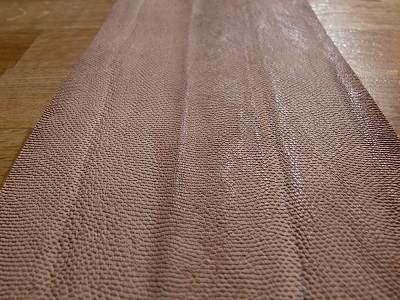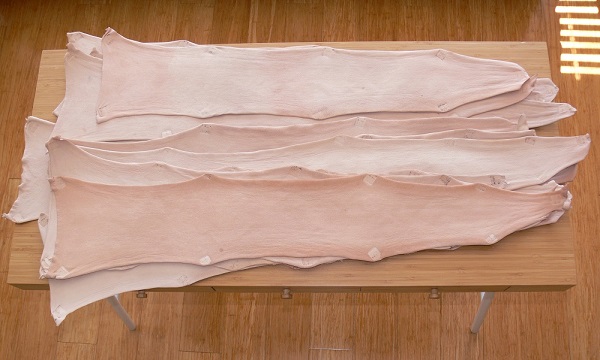|
Efficacy of the Kangaroo tail strop comes from its texture
The wider and longer strops come from mature animals that had time to develop deep texture in their tails.
The strops that are 10+ cm wide have pronounced rough texture, while the 5 cm wide strops coming from younger animals have shallow texture and are more flexible.
Of the 10 cm and wider strops, the longer strop means the longer was the tail and the older was the animal. So the strops 60+ cm long are more textured than the strops 50 cm long.
If you already have experience with cow/horse hanging strops, you will find feeling from the Kangaroo tail strop very different - as you stroke the blade rattles on the strop texture, "drags" and feels "sticky" on the strop.
Hanging strop is not for deburring - it is part of finishing the deburred edge. Cleaning the edge apex for better retention.
Hanging strop is good in removing the wire edge, not deburring as such. We therefore use no abrasives with it.
Kangaroo tail works the best of all known hanging strops in removing the wire edge.
The hanging strop imparts micro-convexity to the edge through burnishing, i.e. metal displacement as opposed to abrasion. Todd Simpson made a series of SEM images showing what the hanging strop does to the edge.
Stropping on the textured Kangaroo tail strop removes all loose elements from the edge apex, like a washboard from the laundry, making the edge stronger, and improving the edge retention.
The above describes use of the hanging strop in sharpening. Another use is in the edge maintenance - the Kangaroo hanging strop effectively removes oxidation that forms on the edge in storage, restoring the initial sharpness - strop immediately before cutting.
It also can re-align a moderately rolled edge, and we strop approximately every 1000 cuts.

Kangaroo harvesting
For general public Kangaroos are untouchable.
A limited quanity of Kangaroos are culled each year to control the growth of their population.
Commercial Kangaroo harvesting is strictly regulated, and currently allowed in QLD, SA, WA, and a small area of NSW. Other States and Territories prohibit commercial use of any parts of Kangaroos, even if it is a roadkill.
Each harvested Kangaroo is tagged; this tag can be removed only by the licensed tanneries, and the quantity is reported to the authorities to ensure the number of culled Kangaroos is within the yearly target.
The licensed roo shooter that we get the tails from, says that only a percentage of kangaroos have a tail long enough to cut out a single 50-60 cm hanging strop.
He may skin 30-40 kangaroos a day, yielding only under 10 tails wide and long enough to make a hanging strop. Rarely, he can supply us oversized tails good for strips 10-11 cm wide x 60-70 cm long.
To get the "Macropod Harvesters Licence", the shooter must place five consecutive shots into a 70 mm (under 3") target at 100 meters. Miss one shot and you fail, no second chance.
For humane harvesting head shot is mandatory; shots other than in the head are heavily penalised.
Where the conditions are such as to raise doubts about achieving instantaneous unconsciousness and a sudden and humane death, shooting must not be attempted.
There are strict protocols regarding codes of practice at all levels that are heavily policed.
The licensed shooter must tag every skin with a government controlled tag and submit records of the numbers. He is not allowed to sell raw skins to the general public, must only give them to a licenced processor. The processor can remove the tag and then the shooter can get the processed leather back.
Kangaroo skin processing
Raw skins need to be 'fleshed', using a fleshing machine.
Fleshed skins need to be dehaired. They soak in dehairing chemicals for about three days and get tumbled in a drum to remove the hair.
Remove the dehairing chemicals and neutralize. Tumbled in a drum for this.
Add the tanning agents and an anti-bacterial and anti-fungal. Done in a tumble drum.
This is the stage we call 'pickle'. The leather is still wet.
After pickle there are a variety of finishing processes depending on the end product, and can involve drying, ironing, skimming for thickness, dyeing and coating.
Tail leather for our strop is just dried. No other processing.

|